
The park is Tanzania’s oldest national park and remains the flagship of the country’s tourism industry, providing a major draw to the Northern Safari Circuit encompassing Lake Manyara National Park, Tarangire National Park, Arusha National Park, and the Ngorongoro Conservation Area. Established in 1951, the Serengeti spans 14,763 square kilometers and is famous for the Serengeti wildebeest migration, the world’s largest terrestrial mammal migration. At Serengeti Wildebeest Migration, our Tanzania safari tours highlight this UNESCO World Heritage Site with expert-guided experiences for an unforgettable adventure.
The Serengeti wildebeest migration is a continuous, circular journey across Tanzania’s Serengeti National Park and Kenya’s Maasai Mara Reserve. Driven by the search for food and water, this migration is a lifeline for the Serengeti ecosystem. It ensures the regeneration of grasslands, enriches the soil with nutrients, and maintains the balance between predators and prey. It is often referred to as the “Greatest Show on Earth” due to its sheer scale and drama.
Key Highlights:
The Serengeti wildebeest migration is fueled by three primary factors:
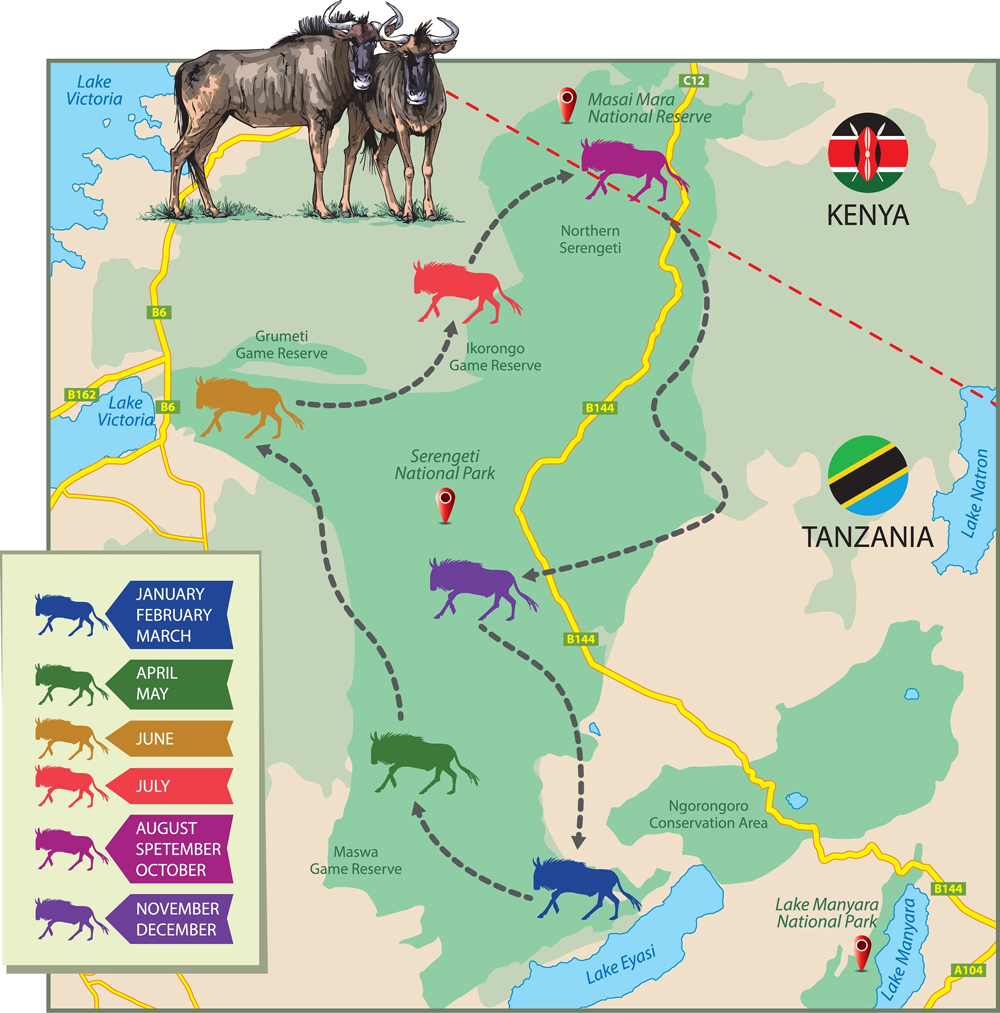
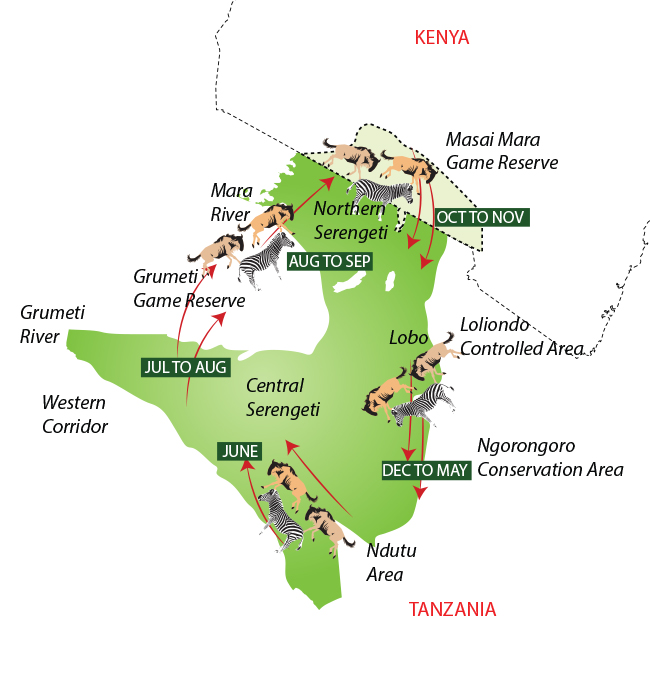
The Serengeti wildebeest migration follows a predictable, clockwise route:
The Great Wildebeest Migration is a year-round phenomenon that follows a circular route through the Serengeti National Park in Tanzania and the Masai Mara National Reserve in Kenya. To help you visualize and plan your safari, here’s a detailed month-by-month guide to the migration, including key locations, weather conditions, and what to expect during each phase of the migration.
Southern Serengeti, Ndutu Conservation Area, and Ngorongoro Conservation Area.
Warm and humid, with average highs of 81°F (27°C) and lows of 60°F (15°C).
Over 500,000 wildebeest calves are born during this period. Predators like lions, cheetahs, and hyenas are abundant, preying on vulnerable calves. Lush green landscapes perfect for photography.
Ndutu Conservation Area and southern Serengeti.
Similar to January, with average highs of 84°F (29°C) and lows of 61°F (16°C).
Calving peaks, with thousands of calves born daily. Predator action intensifies as big cats hunt newborn calves.
Central Serengeti (Seronera region).
Warm, with temperatures ranging from 13°C (55°F) to 37°C (99°F).
Herds begin moving northward toward the central Serengeti. The long rains start, rejuvenating the grasslands.
Central Serengeti (Seronera and Moru Kopjes).
Wet and warm, with occasional rainfall.
Herds disperse across the central plains, grazing on fresh grass. Fewer tourists, making it a quieter time to visit.
Western Serengeti (Grumeti region).
Similar to April, with warm temperatures and occasional rain.
Herds move toward the Grumeti River, where the first river crossings occur. Crocodiles and predators await at the riverbanks.
Northern Serengeti.
Warm, with average highs of 32°C (90°F) and lows of 13°C (55°F).
Herds continue moving north toward the Mara River. Some herds may cross into the Masai Mara as early as late June.
Northern Serengeti and Masai Mara.
Warm and dry, with temperatures ranging from 17°C (63°F) to 32°C (90°F).
The first Mara River crossings occur, with dramatic scenes of wildebeest plunging into the river. Predators and crocodiles create intense wildlife action.
Masai Mara (Kenya) and northern Serengeti.
Warm and dry, with temperatures up to 40°C (104°F) during the da
The Mara River crossings reach their peak, with thousands of wildebeest crossing daily. Herds spread across the Masai Mara, grazing on lush grasslands.
Masai Mara and northern Serengeti.
Similar to August, with warm and dry conditions
Wildebeest mating season begins, with intense competition among males. River crossings continue, though at a slower pace.
Northern Serengeti and Masai Mara.
Warm, with temperatures ranging from 17°C (63°F) to 32°C (90°F).
Herds begin moving back toward the Serengeti. The short rains start, rejuvenating the grasslands in the south.
Central Serengeti (Seronera region).
Warm and wet, with temperatures up to 35°C (95°F).
Herds move southward through the central Serengeti. The landscape turns green and lush after the rains.
Southern Serengeti and Ndutu.
Warm and wet, with temperatures ranging from 17°C (63°F) to 35°C (95°F).
Herds arrive in the southern Serengeti, preparing for the next calving season. The cycle begins anew.
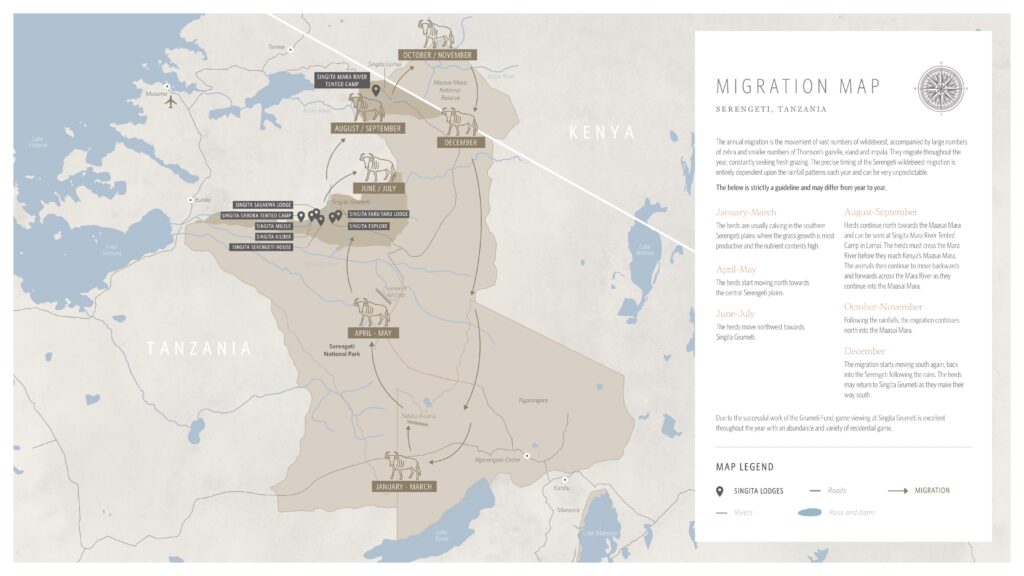
Witness the awe-inspiring Great Wildebeest Migration in Tanzania’s Serengeti National Park with our exclusive Serengeti Wildebeest Migration Packages. Whether you’re looking for a private safari, a cultural immersion, or a luxurious escape, our packages are designed to provide an unforgettable experience. From the dramatic river crossings to the calving season, each tour offers a unique opportunity to witness one of nature’s most spectacular events.
Witness the awe-inspiring Great Wildebeest Migration in Tanzania’s Serengeti National Park with our exclusive Serengeti Wildebeest Migration Packages. Whether you’re looking for a private safari, a cultural immersion, or a luxurious escape, our packages are designed to provide an unforgettable experience. From the dramatic river crossings to the calving season, each tour offers a unique opportunity to witness one of nature’s most spectacular events.
Southern Serengeti (Ndutu area)
Witness thousands of wildebeest calves being born daily. Thrilling predator action as lions, hyenas, and cheetahs hunt the vulnerable newborns.
1-5 January:
○ Per person sharing: US$ 5,610
○ Solo traveler: US$ 7,860
6-31 January:
○ Per person sharing: US$ 4,780
○ Solo traveler: US$ 5,710
February-March:
○ Per person sharing: US$ 4,855
○ Solo traveler: US$ 6,840
Northern Serengeti (Mara River area)
Witness the dramatic Mara River crossings, where wildebeest brave crocodile-infested waters. Enjoy predator action as lions, leopards, and hyenas hunt along the riverbanks.
June::
○ Per person sharing: US$ 3,940
○ Solo traveler: US$ 4,825
July-September:
○ Per person sharing: US$ 6,015
○ Solo traveler: US$ 8,330
October:
○ Per person sharing: US$ 4,870
○ Solo traveler: US$ 5,755
For a more immersive experience, our 7-day/6-night safari takes you deeper into the Serengeti, allowing you to follow the herds across different regions and witness key events like river crossings and predator interactions.
Witness thousands of wildebeest calves being born daily.
Thrilling predator action as lions, cheetahs, and hyenas hunt the newborns.
1-5 January:
○ Per person sharing: US$ 7,850
○ Solo traveler: US$ 9,950
6-31 January:
○ Per person sharing: US$ 6,920
○ Solo traveler: US$ 8,450
February-March:
○ Per person sharing: US$ 7,100
○ Solo traveler: US$ 9,200
Witness the dramatic Mara River crossings, where wildebeest brave crocodile-infested waters. Predator action as lions, leopards, and hyenas hunt along the riverbanks.
June:
○ Per person sharing: US$ 6,500
○ Solo traveler: US$ 7,800
July-September:
○ Per person sharing: US$ 8,200
○ Solo traveler: US$ 10,500
October:
○ Per person sharing: US$ 6,800
○ Solo traveler: US$ 8,100
For an unparalleled wildlife adventure, experience the Great Migration in Tanzania’s Serengeti National Park with a 7-day/6-night luxury safari. From July to October, witness thousands of wildebeest braving the Mara River crossings and journeying between the Serengeti and Kenya’s Masai Mara National Reserve. This exclusive package offers front-row seats to one of nature’s most spectacular events, combined with world-class luxury and service.
Witness the dramatic Mara River crossings, where wildebeest brave crocodile-infested waters. Predator action as lions, leopards, and hyenas hunt along the riverbanks. Stay at Singita’s luxurious lodges, offering exclusive access to prime migration viewing locations. Enjoy private game drives, guided walks, and bespoke safari experiences.
July:
○ Per person sharing: US$ 15,000
○ Solo traveler: US$ 18,500
August-September (peak season):
○ Per person sharing: US$ 17,500
○ Solo traveler: US$ 21,000
October:
○ Per person sharing: US$ 14,000
○ Solo traveler: US$ 16,800
The Serengeti wildebeest migration is not just about the wildebeest—it’s a complex ecosystem involving a diverse array of species. From the wildebeest leading the charge to the predators that follow, each plays a vital role in this natural spectacle. Here’s a closer look at the key wildlife involved in the Great Migration.
Their mass movement is essential for the Serengeti ecosystem:
With over 1.5 million wildebeest participating in the migration, they are the undisputed stars of this natural phenomenon.
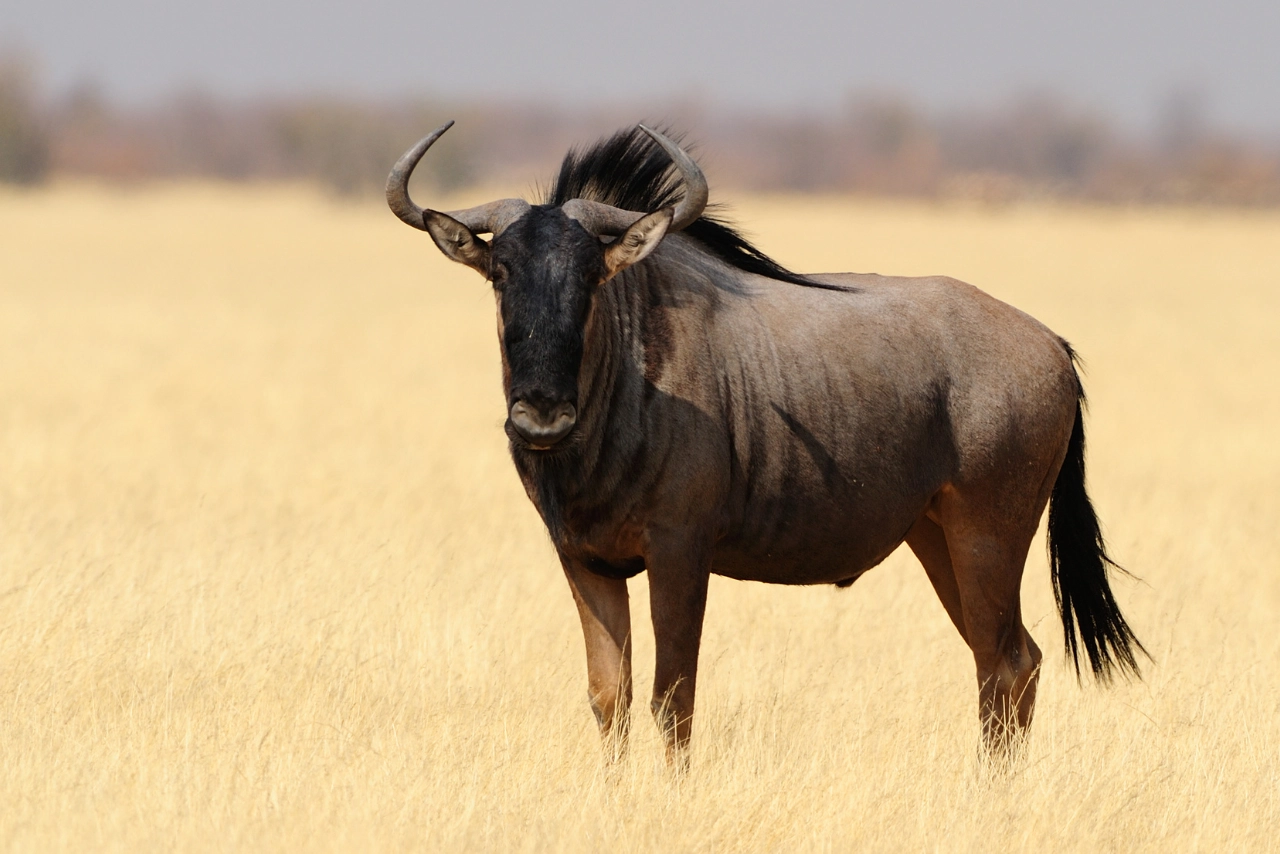
Zebras
The Great Migration is a feast for predators, providing ample opportunities to hunt and thrive.
The Mara and Grumeti rivers are infamous for their large populations of Nile crocodiles, which lie in wait for the migrating herds. These river crossings are some of the most perilous moments of the migration:
The Serengeti wildebeest migration is a perfect example of nature’s interconnectedness:
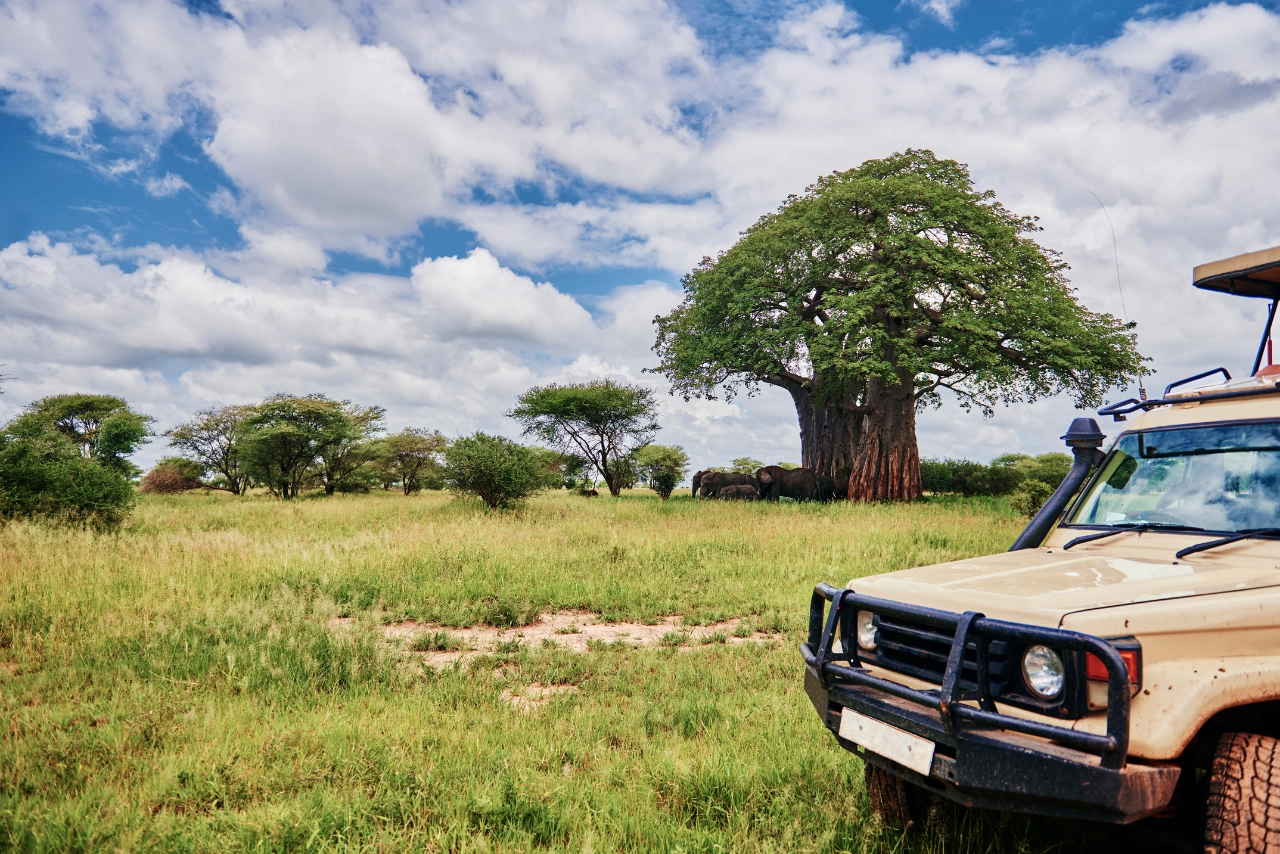
The Serengeti, a name derived from the Maasai word siringet, meaning “the place where the land runs forever,” is one of the most iconic and expansive wilderness areas in the world. Located in northern Tanzania, it is a land of sweeping grass plains, rocky outcrops, woodlands, and fertile volcanic soils, making it a haven for wildlife and a quintessential African safari destination. Here’s a detailed overview of the Serengeti ecosystem, its significance, and what makes it a must-visit for any safari enthusiast:
The Serengeti is synonymous with the Great Wildebeest Migration, the largest overland migration on Earth. Here’s what makes it so extraordinary

While the Great Wildebeest Migration is the Serengeti’s star attraction, the ecosystem is teeming with wildlife year-round:
Witnessing the Serengeti wildebeest migration is a bucket-list experience, and choosing the right safari and accommodation can make all the difference. Whether you’re looking for luxury, budget-friendly options, or unique experiences like hot air balloon rides, this guide covers everything you need to plan your perfect migration safari.
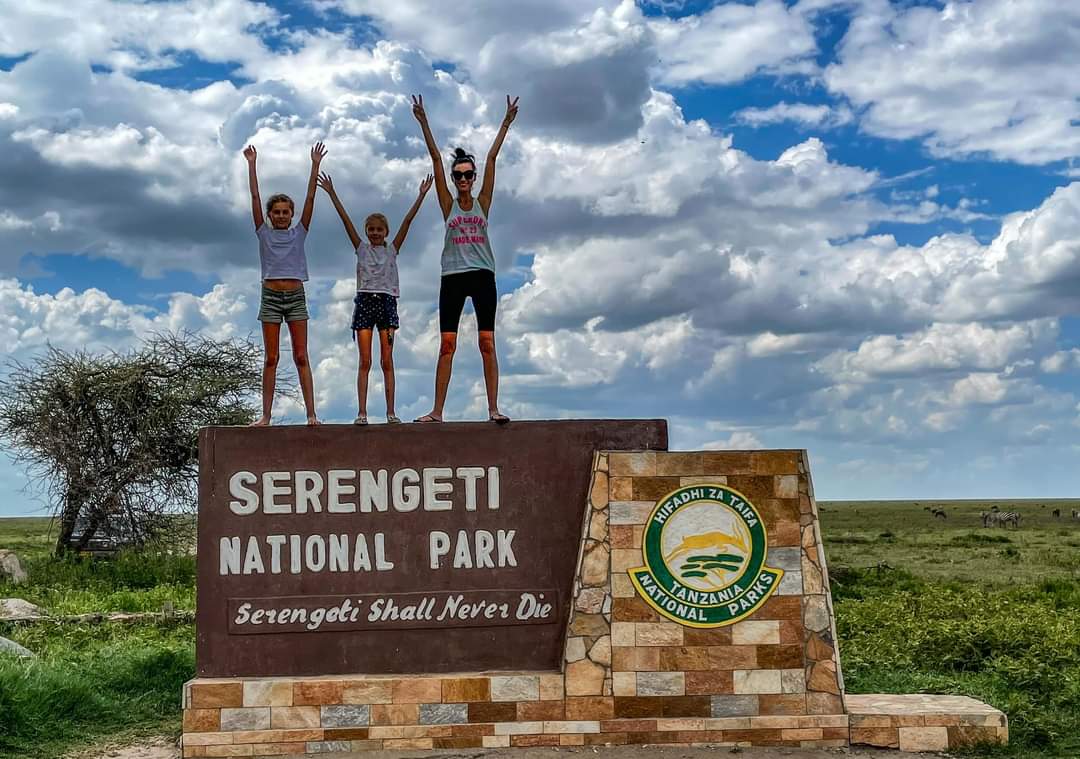
We are offer Serengeti wildebeest migration Safari-specific tours, designed to give visitors the best chance to witness iconic moments like Mara river crossings or the calving season. These tours cater to all budgets and preferences, with expert guides who understand the migration patterns and can maximize your wildlife sightings.
| Option | Pros | Cons |
| Private Safaris | – Personalized and intimate experience. – Tailored to your preferences. | – Higher cost. |
| Group Safaris | – More affordable. – Social experience with fellow travelers. | – Less flexibility in itinerary. |
For travelers on a budget, there are several ways to experience the Serengeti wildebeest migration without breaking the bank:
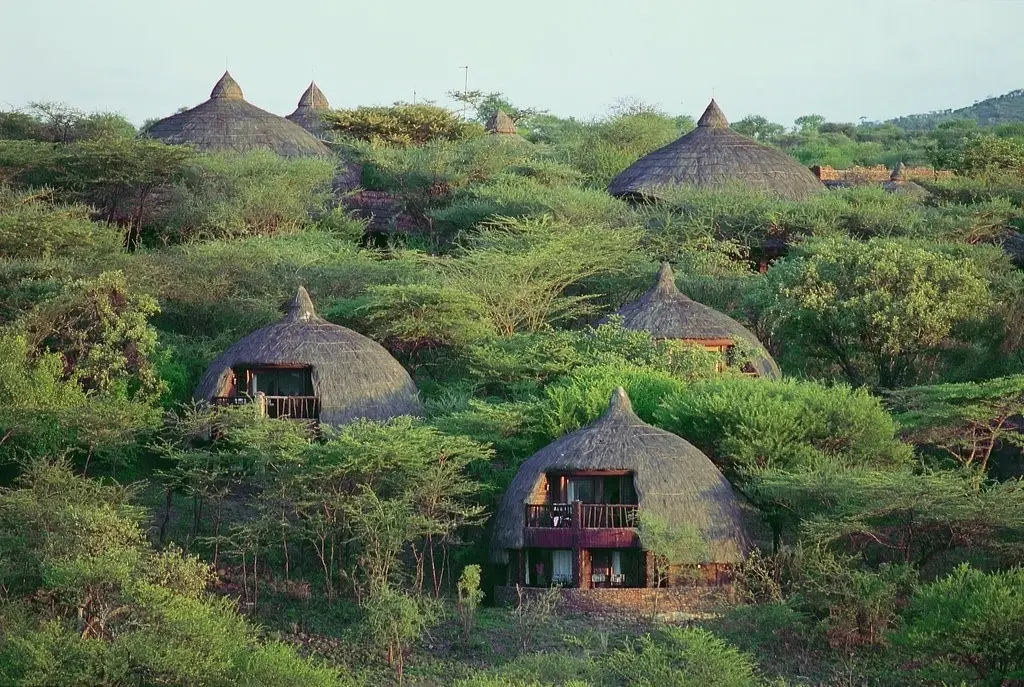
Accommodation options along the migration route cater to all preferences and budgets, ensuring you’re always close to the action.
| Option | Features | Best For |
| Luxury Accommodation | – Gourmet meals, spa treatments, and impeccable service. – Expert guides. | Travelers seeking comfort and exclusivity. |
| Budget Accommodation | – Rustic and affordable. – Closer connection to nature. | Adventurous travelers on a budget. |
Mobile camps are a fantastic option for migration viewers. These camps move with the herds, ensuring you’re always in the heart of the action. They offer a unique blend of comfort and adventure, with the added advantage of being close to the migration throughout your stay.
The Serengeti wildebeest migration is one of the most spectacular wildlife events on Earth. To make the most of this natural wonder, it’s essential to stay in the right location at the right time. Here’s a season-by-Serengeti Migration season guide to the best accommodation options for witnessing the migration.
Calving in the Southern Serengeti.
Ndutu Plains, near the Ngorongoro Conservation Area.
Ndutu Safari Lodge: Prime location for calving and predator action. Lake Masek Tented Camp: Close to the calving grounds with excellent wildlife viewing. Sanctuary Kichakani Serengeti Camp: Offers a front-row seat to the calving season.
Witness the birth of thousands of wildebeest calves. Intense predator-prey interactions with lions, cheetahs, and hyenas.
Herds move towards the Western Corridor.
Central Serengeti, Seronera.
Serengeti Serena Safari Lodge: Comfortable and well-located for wildlife viewing. Kubu Kubu Tented Camp: Offers a mix of comfort and proximity to the herds. Dunia Camp: Secluded and intimate, perfect for witnessing the migration.
Herds in transit, creating dynamic predator-prey interactions. Excellent game viewing in the central plains.
Dramatic river crossings in the Northern Serengeti.
Mara River.
Singita Grumeti Reserves: Luxury lodges with front-row seats to the crossings. Serengeti Mara Camp: Located near the Mara River for optimal viewing. Lamai Serengeti Camp: Offers stunning views of the migration and river crossings.
Witness the iconic and perilous Mara River crossings. Crocodile encounters and intense wildlife drama.
Herds graze in the Maasai Mara, Kenya.
Maasai Mara.
Governor’s Camp: A classic safari camp with excellent wildlife viewing. Mara Serena Safari Lodge: Offers panoramic views of the Mara plains. Little Governors’ Camp: Intimate and luxurious, perfect for photography.
Lush grazing lands attract large herds. Ideal for photography and relaxed wildlife viewing.
Herds return to the Southern Serengeti.
Northern & Central Serengeti.
Sayari Camp: Located in the northern Serengeti, offering excellent wildlife viewing. Kati Kati Tented Camp: A mobile camp that follows the herds.
Herds move southward, preparing for the next calving season. Quiet and serene, with fewer tourists.
Witnessing the Serengeti wildebeest migration is a once-in-a-lifetime experience. To make the most of your trip, careful planning is essential.
The Serengeti wildebeest migration is a year-round event, but the experience varies depending on the season:
Your choice of accommodation can significantly impact your safari experience. Here are the best options based on your budget and preferences:
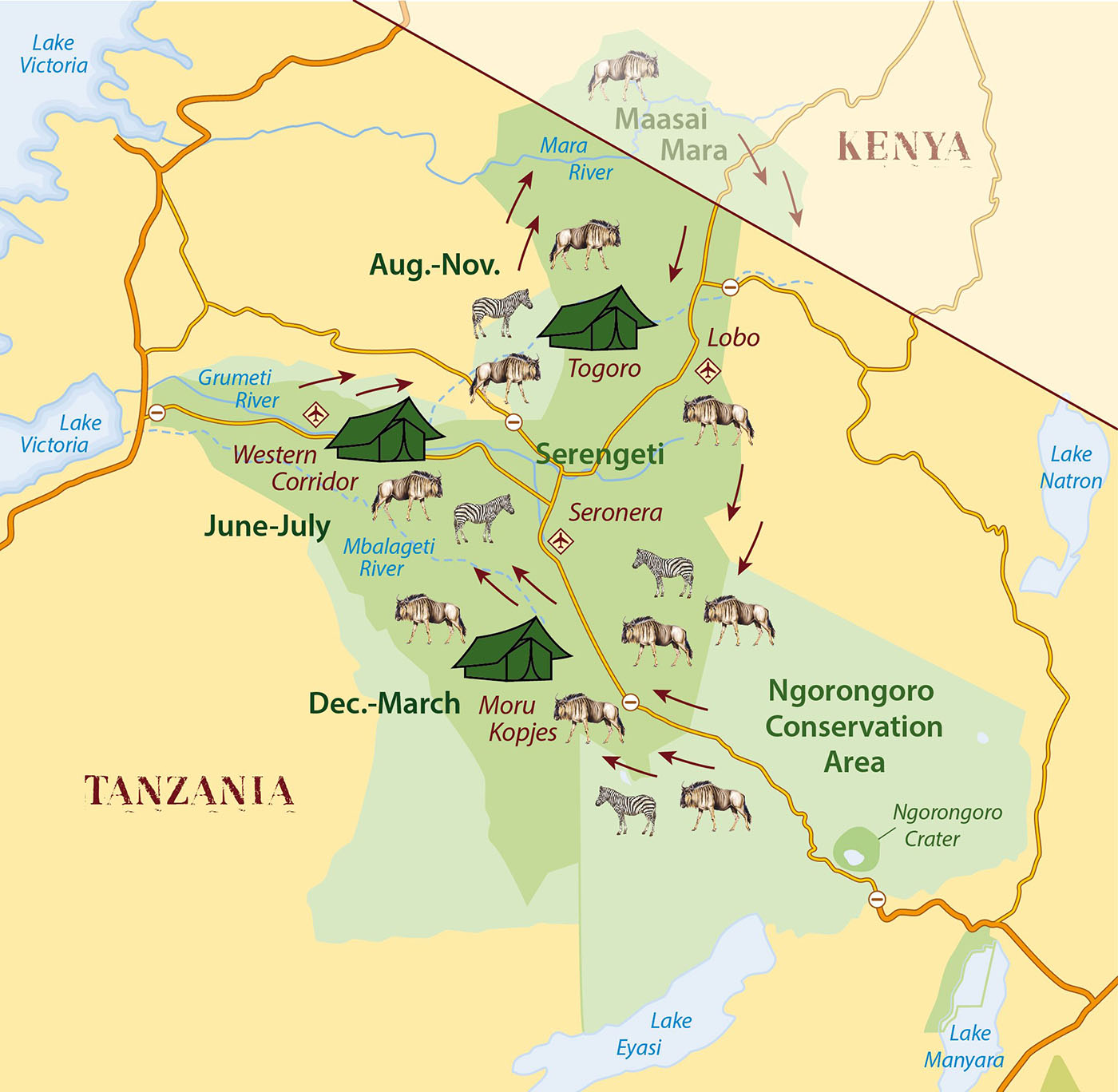
A typical Great Wildebeest Migration safari lasts 5-7 days. This duration allows you to:
The cost of your Wildebeest Migration safari will depend on the time of year, accommodation type, and travel style. Here’s a breakdown:
| Safari Type | Cost Per Person Per Night | Inclusions |
| Luxury Safaris | $1,000+ | High-end lodges, private guides, personalized itineraries, gourmet meals. |
| Mid-Range | 400−700 | Comfortable lodges or camps, guided game drives, meals. |
| Budget Safaris | 150−300 | Basic lodges or camping, shared game drives, self-catering or simple meals. |
Note: Park fees in the Serengeti are approximately $70-80 per person per day.
The Serengeti National Park is a vast and diverse ecosystem, offering unique safari experiences in different regions. Whether you’re drawn to the Great Migration, predator sightings, or dramatic river crossings, understanding the key characteristics of the Ndutu, Seronera, and Western Corridor areas will help you plan the perfect safari. Here’s a detailed comparison of these three iconic safari areas.
Southeastern Serengeti, close to the Ngorongoro Conservation Area
December to April: Calving season of the Great Migration.
Great Migration Calving: Over 400,000 wildebeest calves are born. Predator Action: Lions, cheetahs, and hyenas are highly active.
Intense predator-prey interactions during calving. Large herds of wildebeest, zebras, and gazelles.
Open grasslands with seasonal lakes (Lake Ndutu and Lake Masek). Acacia woodlands.
Easy access from Ngorongoro and Arusha. Seasonal tented camps.
Moderate to high during the calving season.
Calving season spectacle: Predators converge for newborns.
Seasonal tented camps.
Best for witnessing the calving season (December-April). Excellent for big cat sightings. Quieter during off-season months.
Western Serengeti, extending towards Lake Victoria.
May to July: Great Migration river crossings at the Grumeti River.
Grumeti River Crossings: Dramatic and perilous crossings with Nile crocodiles. Resident wildlife, including elephants, giraffes, and hippos.
Dramatic river crossings during the migration. Abundant lions, leopards, and hyenas.
Riverine forests, rolling hills, and the Grumeti and Mbalageti rivers.
More remote, with fewer lodges. Private reserves like Grumeti Reserves offer exclusive experiences.
Less crowded compared to Seronera, except during migration river crossings.
Grumeti River crossings: Home to some of the largest Nile crocodiles in Africa. Exclusive experiences: Walking safaris and night drives in private reserves.
Fewer lodges, with a focus on luxury in private concessions.
Best during May to July for river crossings. Remote and exclusive safari experience. Opportunities for walking safaris and night drives.
Central Serengeti.
Year-round, with peak wildlife viewing from March to May.
Predator Capital of the World: High concentrations of lions, leopards, and cheetahs. Diverse wildlife, including elephants, giraffes, and buffalo
Guaranteed sightings of big cats. Year-round wildlife action.
Rolling plains, rivers (Seronera River), and kopjes (rock outcrops).
Well-developed infrastructure with many lodges and camps. Easily accessible from Seronera Airstrip.
High visitor traffic, especially during peak months.
Predator capital of the world: Guaranteed sightings of lions, leopards, and cheetahs.
Wide range of lodges and camps, from budget to luxury.
Best during May to July for river crossings. Remote and exclusive safari experience. Opportunities for walking safaris and night drives.
The Serengeti National Park is one of the most iconic safari destinations in the world, but getting there requires some planning. Whether you prefer flying or driving, there are several ways to access the park, each offering a unique experience. Here’s a detailed guide to help you choose the best route to the Serengeti.
Flying is the quickest and most convenient way to reach the Serengeti. Several airstrips serve different regions of the park, allowing you to land close to your lodge or camp.
| Airstrip | Location | Best For |
| Seronera Airstrip | Central Serengeti | Accessing Seronera lodges and the central plains. Ideal for big cat sightings. |
| Kogatende Airstrip | Northern Serengeti | Witnessing the Mara River crossings during the Great Migration. |
| Lamai Airstrip | Northern Serengeti | Staying in the remote Lamai Wedge area. Fewer crowds, excellent game viewing. |
| Ndutu Airstrip | Southeastern Serengeti | Visiting during the calving season (December-March). Predator action. |
| Grumeti Airstrip | Western Corridor | Accessing lodges near the Grumeti River. Great for river crossings. |
| Kirawira Airstrip | Western Corridor | Luxury lodges in the Western Corridor. Intimate safari experience. |
Pros of Flying
Driving to the Serengeti offers an adventurous and immersive experience, allowing you to explore Tanzania’s countryside and other national parks along the way.
From Arusha
| Gate | Location | Best For |
| Naabi Hill Gate | Southern Serengeti | Main entrance for those coming from Arusha or Ngorongoro. |
| Ndabaka Gate | Western Corridor | Access from Mwanza (1.5 hours). Scenic drive through local villages. |
| Klein’s Gate | Northeastern Serengeti | Remote access to the Lobo area. Fewer crowds. |
| Bologonja Gate | Northern Serengeti | Near the Kenya border. Rugged, off-the-beaten-path routes. |
Road Conditions
Many travelers opt for a combination of flying and driving to maximize their experience. For example:
Most visitors fly into Kilimanjaro International Airport (JRO) or Arusha Airport (ARK). From there, you can take a domestic flight or drive to the Serengeti.
Airlines Serving Kilimanjaro and Arusha
Experience the iconic Serengeti Wildebeest Migration, one of nature’s greatest spectacles, in Tanzania’s Serengeti National Park. Witness thousands of wildebeest and zebras crossing the Mara River, explore diverse wildlife-rich regions like the Central and Northern Serengeti, and enjoy activities like game drives, hot air balloon safaris, and cultural interactions. Plan your Serengeti safari with expert operators, tailor your itinerary, and prepare for an unforgettable adventure in the heart of Africa’s wild beauty.
Plan your Serengeti safari based on your budget, time, and interests. Choose from key areas like:
Enjoy activities like game drives, Maasai cultural interactions, hot air balloon safaris, walking safaris, and bush dinners under the stars. Tailor your Serengeti adventure for an unforgettable wildlife experience!
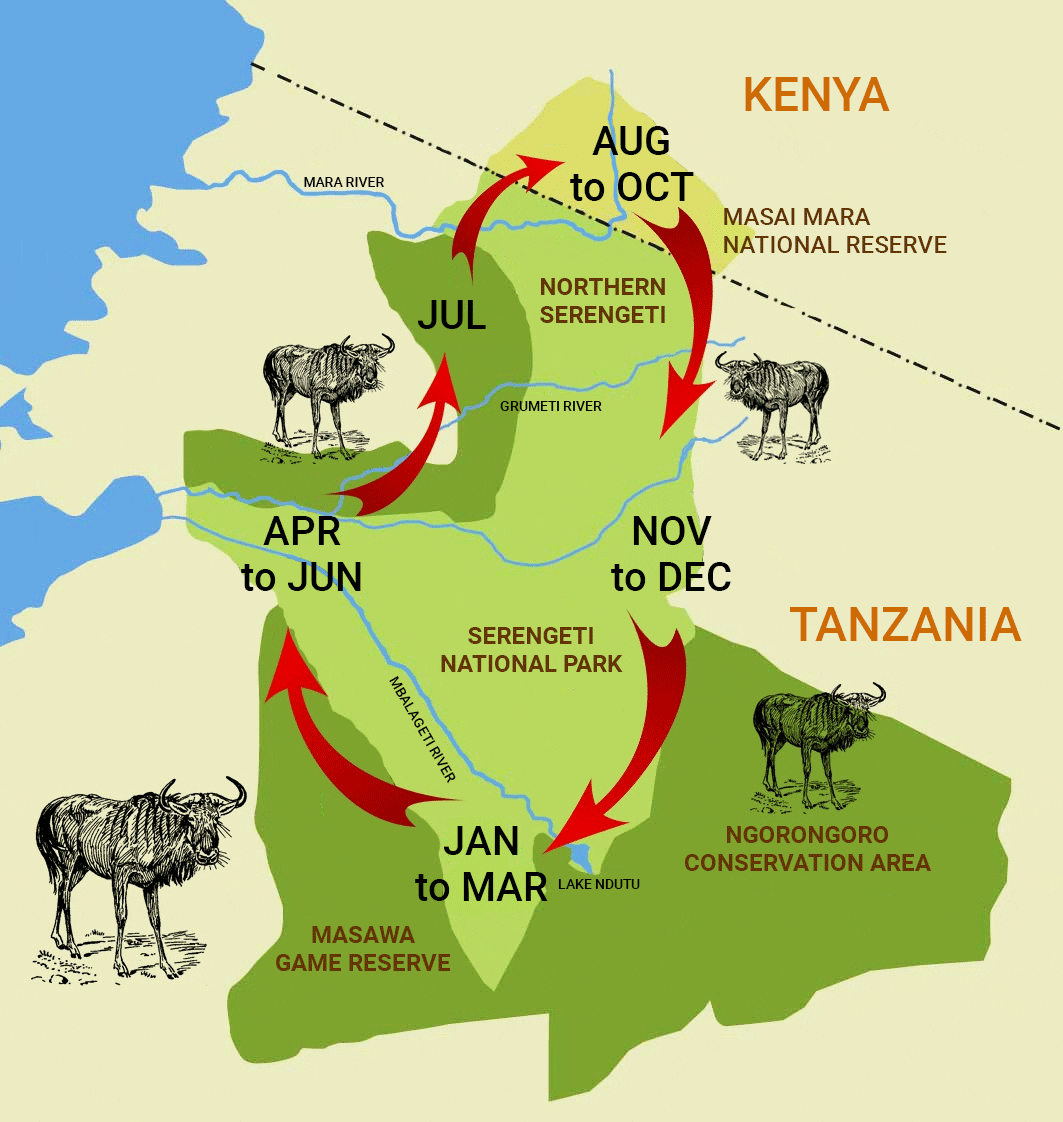
Serengeti safari cost ranges from $1,700 to $8,000 per person, depending on duration, season, and accommodation, excluding flights ($500–$1,500). Our packages include game drives, park fees, meals, and transfers, with options for the Serengeti wildebeest migration safari. Budget tours start at $1,700 for 5 days, while luxury experiences reach $8,000 for 10 days.
Yes, we run safari during the migration of the Wildebeest migration. Our Serengeti migration tours are designed to follow the Serengeti wildebeest migration, offering prime viewing of the 1.5 million animals crossing the plains. Book a tailored tour for an immersive experience.
The area is better than the Masai Mara in December as the animals have moved back south after the Migration in October. The best time to visit Serengeti is June–October for dry weather and river crossings, or January–March for calving season. December offers lush landscapes and southward migration in the Serengeti.
The Serengeti wildebeest migration is a year-round event, with key periods:
Plan your Serengeti wildebeest migration safari accordingly for the best sightings.
The Serengeti has a tropical climate with temperatures ranging from 15°C to 25°C (59°F to 77°F). Dry season (June–October) is sunny with low humidity, while wet season (November–May) brings rain and lush greenery. Pack layers for cool mornings and evenings on your Tanzania safari.
The Serengeti wildebeest migration is visible year-round in Tanzania, with peak river crossings in July–September and calving in January–March. Our tours ensure optimal viewing for the Serengeti wildebeest migration safari.
The great migration spans the year, but July–September is the best month for dramatic river crossings in Tanzania’s Serengeti. January–March is ideal for calving. Book your Serengeti wildebeest migration safari for the best timing.
The Serengeti wildebeest migration is a continuous cycle: calving in January–March, northward in April–June, river crossings in July–September, and southward in November–December. Our tours cover all phases for a complete Tanzania safari.
The Serengeti wildebeest migration is visible year-round, with peak action in July–September for crossings and January–March for calving. Our Serengeti wildebeest migration safari ensures you see the highlights.
The great migration takes place in Tanzania’s Serengeti National Park and Kenya’s Maasai Mara, but the majority of the cycle (about 8 months) is in Tanzania. Experience it with our Serengeti wildebeest migration safari.
How much is a safari in Serengeti? Budget tours start at $1,500 for 5 days, mid-range at $2,500, and luxury at $5,000+. Prices include game drives, accommodations, and fees for the Serengeti wildebeest migration.
Is it safe to travel to Serengeti? Yes, the Serengeti is safe for tourists with guided tours and park regulations. Malaria precautions and vaccinations are recommended. Our tours ensure safety during the Serengeti wildebeest migration safari.
How much does a safari in Tanzania cost? Entry-level tours start at $1,500, mid-range at $2,500, and luxury at $5,000+. Costs include park fees, accommodations, and guided tours for the Serengeti wildebeest migration safari.
The best time to visit Tanzania is June–October for dry weather and wildlife viewing, or January–March for calving season. Plan around the Serengeti wildebeest migration for the best experience.
Is Tanzania safe? Yes, Tanzania is safe for tourists, especially in national parks and tourist areas. Follow standard precautions like avoiding isolated areas at night and using guided tours for safaris.
How much does it cost to visit Serengeti National Park? Park entry is $70/day per person, with tours starting at $1,500 for 5 days. Luxury options reach $8,000, including the Serengeti wildebeest migration safari.
Are drones allowed in Tanzania? Drones require a permit from the Tanzania Civil Aviation Authority (TCAA) and are prohibited in national parks like Serengeti without special permission. Check regulations before your trip.
The best time of year to visit the Serengeti is June–October for dry weather and river crossings, or January–March for calving. Our tours align with the Serengeti wildebeest migration for optimal sightings.
What shots do you need for Tanzania? Required vaccinations include yellow fever (if from endemic areas), and recommended are hepatitis A/B, typhoid, rabies, and malaria prophylaxis. Consult your doctor before your Tanzania safari.
Is Tanzania a third world country? Tanzania is classified as a developing country with growing tourism and economy. It’s safe for travelers, especially in parks like Serengeti, offering world-class safaris.
Is Tanzania a poor country? Tanzania is a lower-middle-income country with poverty challenges, but its tourism industry, including Serengeti safaris, contributes significantly to the economy.
Is Tanzania a wealthy country? Tanzania is not considered wealthy but has natural resources and a growing economy driven by tourism, agriculture, and mining. Safaris support local communities.
How much of Africa is poor? Poverty varies across Africa, with about 40% of the population below the poverty line. Tanzania’s tourism, like Serengeti safaris, helps alleviate poverty through employment.
How much is a safari holiday? A Tanzania safari holiday costs $1,500–$8,000 per person, depending on duration and luxury. Our packages include the Serengeti wildebeest migration safari for value.
What is a photo safari? A photo safari is a guided tour focused on photography, with extended stops for shots. Our Serengeti tours offer photo safaris during the Serengeti wildebeest migration.
What is there to do in the Serengeti? Game drives, hot air balloon rides, walking safaris, and cultural visits. Don’t miss the Serengeti wildebeest migration safari.
Are there elephants in the Serengeti? Yes, the Serengeti has large elephant herds, often seen during game drives or the Serengeti wildebeest migration safari.
Where do you fly to for Serengeti? Fly to Kilimanjaro International Airport (JRO), then transfer to Arusha for your Serengeti tour.
Where do you fly into for Tanzania safari? Most fly into Kilimanjaro International Airport (JRO) for Northern Circuit safaris like Serengeti.
How do you get to Serengeti National Park? Fly to Kilimanjaro, drive or fly domestically to Seronera Airstrip, then game drive to your lodge.
Are there giraffes in the Serengeti? Yes, giraffes are abundant in the Serengeti, often seen browsing acacia trees during safaris.
How many cheetahs are in the Serengeti? The Serengeti has around 500–600 cheetahs, making it a prime spot for sightings during the Serengeti wildebeest migration safari.
How big is Serengeti? The Serengeti National Park covers 14,763 square kilometers (5,700 square miles), larger than Connecticut.
What is Serengeti National Park famous for? The Serengeti is famous for the Serengeti wildebeest migration, Big Five, and diverse ecosystems.
Are there lions in the Serengeti? Yes, the Serengeti has one of the largest lion populations in Africa, with over 3,000 lions.
What should I pack for the Serengeti safari? Pack neutral-colored clothing, sturdy shoes, hat, sunscreen, insect repellent, binoculars, camera, lightweight jacket for evenings, and malaria prophylaxis. For the Serengeti wildebeest migration safari, bring zoom lenses for photography.
Our Tanzania safari packages are designed for adventure and value:
Packages include modern 4×4 Land Cruisers (2016–2022), English-speaking guides, park fees, meals, bottled water, and airport transfers from Kilimanjaro. Maximum 4 guests per vehicle ensure window seats.
Witness the Great Serengeti Wildebeest Migration – Secure Your Spot with Just 30% Deposit!
The Great Wildebeest Migration is one of the most spectacular natural events on Earth, and now is the perfect time to plan your adventure. With only a 30% deposit, you can confirm your spot for this unforgettable safari experience, available for booking 6 to 12 months in advance. Don’t miss the chance to witness millions of wildebeest, zebras, and antelopes as they traverse the Serengeti in search of greener pastures.
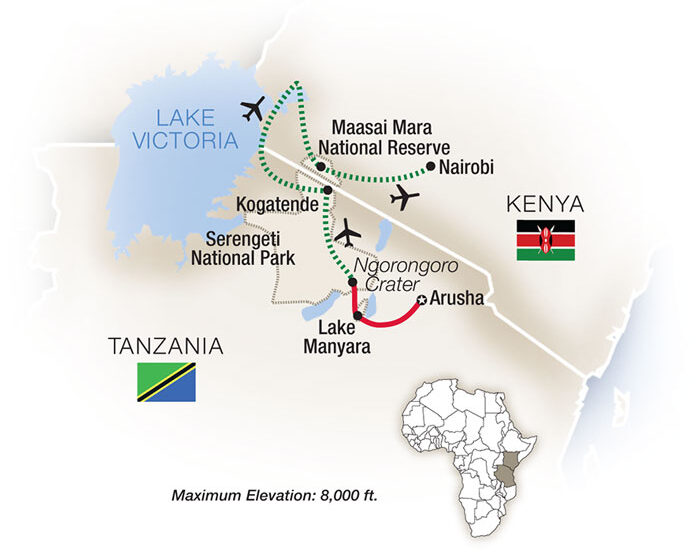
The Serengeti Wildebeest Migration is a once-in-a-lifetime experience that requires early planning. With just a 30% deposit, you can secure your spot and start counting down to the adventure of a lifetime.
